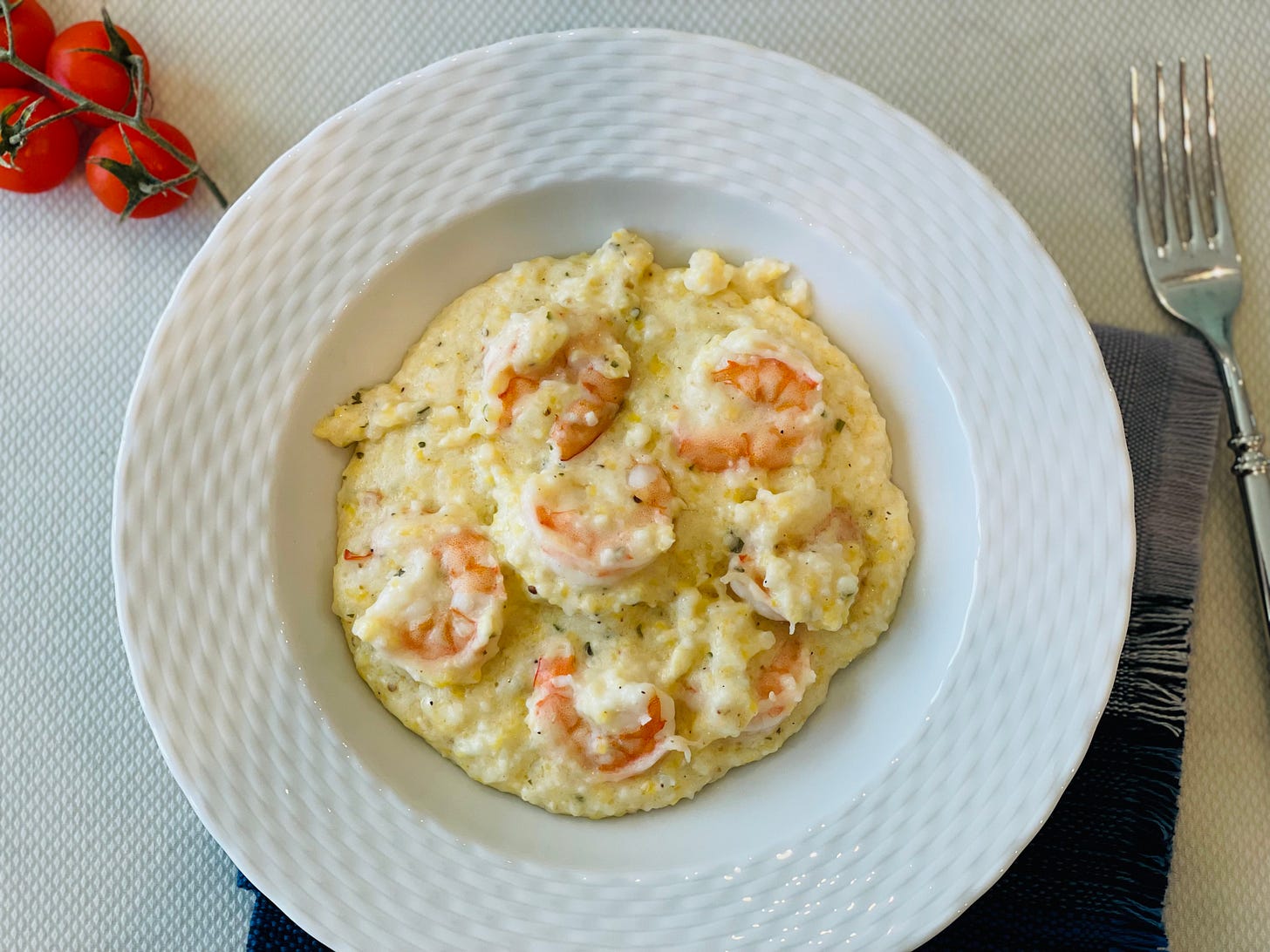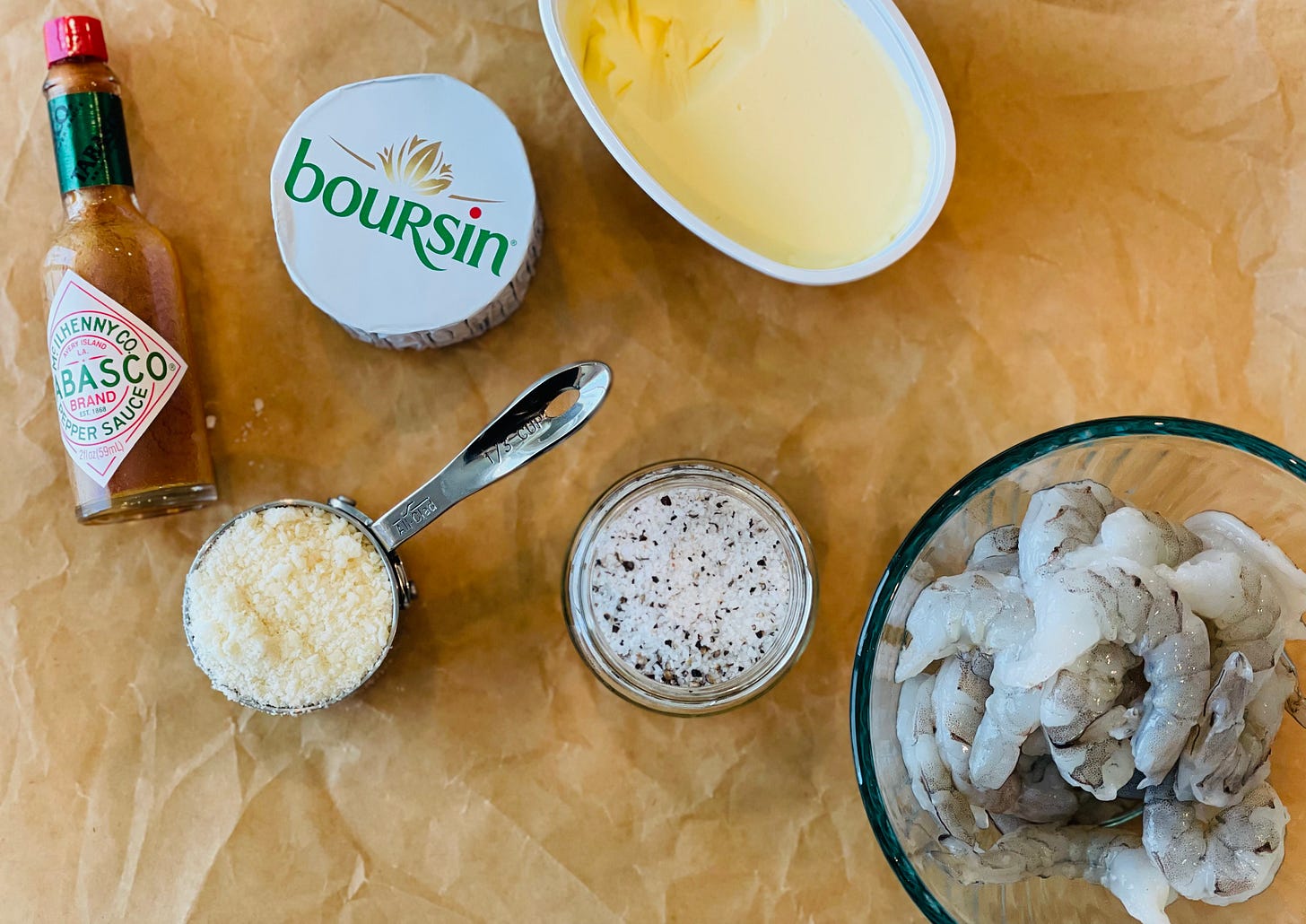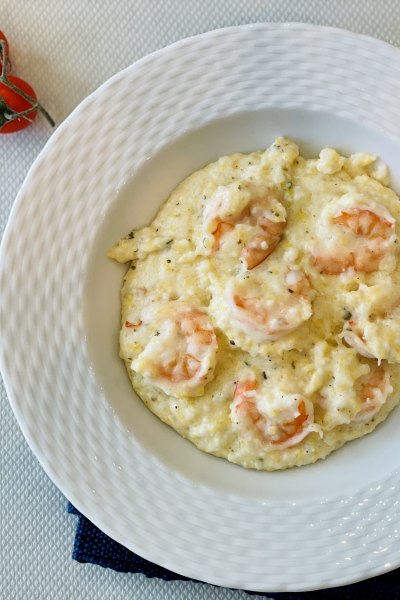Hello W4D peeps! Since it’s just us squirrel friends, let’s get real: sometimes you want meal-making to be as hands off as possible, and boy, does Elizabeth have a hands-off recipe for you! How about a luscious, steamy pot of Shrimp ‘n’ Grits?? And to wash it down, she’s got a BEE-u-tiful classic cocktail for paid subscribers! To the content, as they say…
Congratulations to HEATHER OLEARI for winning
the “BUTTER OF EUROPE: FRENCH BUTTER” GIVEAWAY!!
If you’re friends with Heather, hit her up for some delicious buttery treats—she’s good for it. :) Thanks for being a W4D Subscriber, Heather!!
ONE POT SHRIMP ‘N’ GRITS
EK: Who doesn’t love Shrimp and Grits? I mean, it’s a dish of hot, creamy, ground corn cooked al dente with just the right amount of spices, herbs and rich dairy punctuated with big, fat, succulent pink shrimp. It’s like a warm, cozy hug in a bowl!
AU: I love shrimp and grits, but never make it because of all the tales I’ve heard about how you can’t stop stirring grits (lest you’d like lumps!). It seems labor intensive to me… so it has always been a “restaurant only” dish for me.
EK: My journey with “shrimp and grits” all started with the shrimp and grits that I ate growing up in North Carolina. It is well-known in food circles that the father of modern day Shrimp and Grits is Bill Neal, the chef founder of Crooks Corner (restaurant) in Chapel Hill, NC. And, his legacy is far and wide.
Chef Bill Smith took over for Neal in 1993 and kept Neal’s classic dish on the menu until 2019 when he retired. Young cooks who worked for Neal—and later, Smith—also took his version of shrimp and grits to their next restaurant jobs, and many eventually opened their own restaurants where they served it there, as well.
Neal’s version of shrimp and grits featured a base of cheese grits, sautéed shrimp, bacon, mushrooms and scallions. As chefs are want to do, each new chef added their own touch including shrimp stock, andouille sausage, tomatoes and brown gravy, among other things.
Today, ‘Shrimp and Grits’ is ubiquitous in the South and beyond but the variations are many, and most of the dishes are a far cry from its humble fisherman’s roots.
The origins of shrimp and grits in the USA are from the low country region of South Carolina, but the dish—like many recipes—goes back way further than that. You can read a little about the history of the dish in this article by Erin Byers Murray.
Food is all about history and tradition, and the recipe as I understand it, was a simple mix of corn grits, maybe some butter, and the shrimp—caught by the fisherman—all cooked up in one pot. The dish was often referred to as Breakfast Shrimp and Grits or Shrimps and Hominy.
The earliest recipe that I could find is from the 1930 edition of the cookbook, “Two Hundred Years of Charleston Cooking.” The shrimp are sautéed in butter and added to hot grits and the proportions are 1 cup of grits and ¼ pound of shrimp per person. (For comparison’s sake, I recommend a 1/2 pound of shrimp per person, based on the many times that I have cooked-and-served shrimp and grits).
I visited cookbook author and the OG southern food expert Nathalie Dupree at her home the same year that her revised “Shrimp and Grits” cookbook came out. That’s when I first had her variation of this simple dish. It is also where I learned her trick of cooking the peeled and deveined shrimp directly in the hot steamy grits. I wrote about the version that I had at her house more than 10 years ago—and in true Nathalie fashion, it was a mix of traditional technique and modern twists as she added baby spinach and cherry tomatoes to the dish.
Tasting the difference in the poached shrimp vs. sauteed (or even grilled) shrimp was a big epiphany for me. The sweet, plump, poached shrimp are so much better with the creamy grits than the often chewy and overcooked shrimp that are cooked in a skillet and poured atop a bed of grits.
Since that time, I have streamlined my version of shrimp and grits. Not only do I think that it is the tastiest version, but it is the easiest as well!
EK: I start with coarse-ground grits. I prefer white or speckled grits and use local grits, either from North Carolina or South Carolina. They are also available online so you can buy them even if you don’t live near the grist mill. Here are some of my favorites : Marsh Hen Mill, Charleston Favorites, Carolina Grits .
AU: WELP. Add “Grits Hoarder” to my resume, because I just ordered one of each!
EK: Isn’t online shopping grand? You get a taste of the Carolinas shipped to you in LA!
EK: Now that I have a rice cooker, I actually cook the grits in a rice cooker! I use a standard measuring cup (not the one that comes with the rice cooker), and measure 2 cups of water, 1 cup of cream or (half and half), and 1 cup of stone-ground grits. I stir them together and set the rice cooker on the “quick” cycle which is 39 minutes.
You can cook them old-school over low heat in a Dutch oven for about the same time, keeping the lid on and stirring occasionally.
Once the grits are cooked, but still have a bite to them (like al dente pasta), it’s time to add the seasonings and a little extra water if they are too stiff. If you cooked the grits in a rice cooker, transfer them to a Dutch oven.
AU: You mentioned that you’ve even made the shrimp ‘n’ grits entirely in the rice cooker… can the folks at home do that, if they want?
EK: That is a yes! I make my Shrimp and Grits entirely in my rice cooker. The reason that I love to cook the grits in the rice cooker is that I can “set it and forget it” and they come out perfect every time. The only thing you need is to add a little extra water to thin out the grits before you add the rest of the ingredients. When I cook grits in a Dutch oven, it’s easy, but you need to stir occasionally and make sure not to let the bottom of the grits burn.
When the grits are done, I add all the other ingredients (including the shrimp) to the pot of my rice cooker. The rice cooker cooks at a lower temperature, so it will take a little longer to poach the shrimp, but if you want to try it, it’s foolproof!
EK: I use a wheel of Boursin cheese to season the grits, along with 1/3 cup of grated Parmigiano-Reggiano and some freshly-ground black pepper. I have used Boursin for as long as I have been cooking to “goose” a lot of dishes.
Recently I saw the French Chef, Ludo LeFebvre teach Selena Gomez how to make a traditional French omelet and he said that Boursin was the “French Velveeta.” It’s good to know that the French have their shortcut tricks, even if Boursin is on a whole ‘nother level from Velveeta! :)
AU: Listen, I love both cheese products! If you go to Ludo’s restaurant, Petit Trois, get the Petit Trois Omelet—the one that he taught Selena to make. It basically contains an ENTIRE WHEEL of Boursin… for one serving.
EK: Stir well to mix everything, and once the grits are back to a simmer, add the raw shrimp to the grits. Give it a good stir, and put the lid on the pot. The shrimp will poach in the hot grits in mere minutes!
Like I said earlier, cooking the raw shrimp in the hot grits is a technique that I learned from Nathalie Dupree. Not only is it a real timesaver, but the shrimp juices season the grits as they cook and deepen the flavor of the dish like a quickie shrimp stock! Best of all, the shrimp do not get overcooked, which is easy to do if you sauté the shrimp separately.
AU: Okay, I can do this—Adding Shrimp ‘n’ Grits to my weeknight meal rotation. This seems as simple as can be!
THE GOODS: THE BEE’S KNEES
Make the “Bee’s Knees” your new Classic Summer Cocktail
EK: I had never heard of a “Bee’s Knees” until a few years ago. Of course, I had heard people use the saying in old movies or maybe in conversation, but I didn’t know that it was a cocktail.
AU: It happens to be one of my friend Lexy’s favorites! That’s when I first heard of it. Her husband, Justin, is an amateur mixologist (my words, not his), and he makes an incredible Bee’s Knees cocktail. Tomorrow is Justin’s birthday, btw (HAPPY BIRTHDAY, JUSTIN!).
EK: When I discovered it, I thought, “where has this been all my drinking life?” In its simplest form, it is lemon juice, honey and gin or vodka. I prefer a Bee’s Knees with gin, but if you are a vodka drinker, it’s am sure that it is equally refreshing. After all, it’s like a delicious boozy lemonade.
Keep reading with a 7-day free trial
Subscribe to "What's 4 Dinner?" to keep reading this post and get 7 days of free access to the full post archives.










